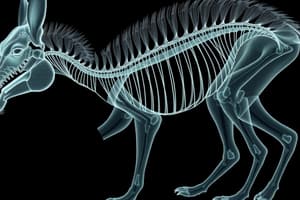Podcast
Questions and Answers
Quels sont les différents embranchements des protozoaires ?
Quels sont les différents embranchements des protozoaires ?
- Spongiaires, Cnidaires, Cténaires
- Sarcomastigophora, Apicomplexa, Ciliophora (correct)
- Plathelminthes, Némathelminthes, Annélides
- Achetes, Oligochetes, Polychetes
Quelles sont les caractéristiques des métazoaires ?
Quelles sont les caractéristiques des métazoaires ?
- Possèdent une seule couche germinale
- Sans corps, acœlomates
- Organismes unicellulaires
- Organismes multicellulaires (correct)
Quel est un exemple de triploblastique acœlomate ?
Quel est un exemple de triploblastique acœlomate ?
- Némathelminthes
- Cnidaires
- Plathelminthes (correct)
- Annélides
Les quel groupe d’animaux sont considérés comme des pseudocœlomates ?
Les quel groupe d’animaux sont considérés comme des pseudocœlomates ?
Quel groupe d'animaux a trois couches germinales ?
Quel groupe d'animaux a trois couches germinales ?
Flashcards
Protozoaires
Protozoaires
Les protozoaires sont des organismes unicellulaires et constituent le groupe le plus primitif du règne animal.
Métazoaires
Métazoaires
Les métazoaires sont des organismes multicellulaires et comprennent une grande diversité d'animaux.
Diploblastiques
Diploblastiques
Les diploblastiques sont des métazoaires qui se développent à partir de deux feuillets embryonnaires: l'ectoderme et l'endoderme.
Triploblastiques
Triploblastiques
Signup and view all the flashcards
Acœlomates
Acœlomates
Signup and view all the flashcards
Study Notes
Animal Classification
- Animaux are divided into Protozoaires and Métazoaires.
- Protozoaires have 5 phyla: Sarcomastigophora, Apicomplexa, Ciliophora, Myxozoa and Microspora.
- Métazoaires are further divided into Diploblastiques and Triploblastiques.
- Diploblastiques include Spongiaires, Cnidaires and Cténaires.
- Triploblastiques are divided into Acœlomates, Pseudocœlomates and Coelomates.
- Acœlomates include Plathelminthes.
- Pseudocœlomates include Némathelminthes.
- Coelomates include Annélides (Achetes, Oligochetes, polychetes).
Protozoaires Characteristics
- Protozoaires are single-celled, eukaryotic, heterotrophic organisms.
- They live in aquatic environments and sometimes as parasites.
- Protozoaires use osmose or phagocytosis.
- They have specialized organelles for locomotion and other functions.
- Their cytoplasm has an endoplasm and an ectoplasm.
- They have a cell membrane, often strengthened by a skeletal structure.
- They have organites like mitochondria, Golgi apparatus, endoplasmic reticulum and digestive vacuoles.
- They have contractile vacuoles for osmoregulation.
- They have a nucleus and enclosed in a nuclear membrane
Studying That Suits You
Use AI to generate personalized quizzes and flashcards to suit your learning preferences.




